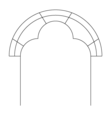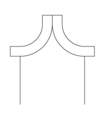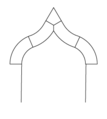- Arch
-
An arch is a structure that spans a space while supporting weight (e.g. a doorway in a stone wall). Arches appeared as early as the 2nd millennium BC in Mesopotamian brick architecture and their systematic use started with the Ancient Romans who were the first to apply the technique to a wide range of structures.
Contents
Technical aspects
The arch is significant because, in theory at least, it provides a structure which eliminates tensile stresses in spanning an open space. All the forces are resolved into compressive stresses. This is useful because several of the available building materials such as stone, cast iron and concrete can strongly resist compression but are very weak when tension, shear or torsional stress is applied to them. By using the arch configuration, significant spans can be achieved. This is because all the compressive forces hold it together in a state of equilibrium. This even applies to frictionless surfaces. However, one downside is that an arch pushes outward at the base, and this needs to be restrained in some way, either with heavy sides and friction or angled cuts into bedrock or similar.
This same principle holds when the force acting on the arch is not vertical such as in spanning a doorway, but horizontal, such as in arched retaining walls or dams.
Even when using concrete, where the structure may be monolithic, the principle of the arch is used so as to benefit from the concrete's strength in resisting compressive stress. Where any other form of stress is raised, it has to be resisted by carefully placed reinforcement rods or fibres. (See Arch bridge.)
History
True arches, as opposed to corbel arches, were known by a number of civilizations in the Ancient Near East, the Levant, and Mexico, but their use was infrequent and mostly confined to underground structures such as drains where the problem of lateral thrust is greatly diminished.[1] A rare exception is the bronze age arched city gate of Ashkelon (modern day Israel), dating to ca. 1850 B.C.[2] An early example of a voussoir arch appears in the Greek Rhodes Footbridge.[3] In 2010, a robot discovered a long arch-roofed passageway underneath the Pyramid of Quetzalcoatl which stands in the ancient city of Teotihuacan north of Mexico City, dated to around 200 AD.[4]
The ancient Romans learned the arch from the Etruscans, refined it and were the first builders to tap its full potential for above ground buildings:
The Romans were the first builders in Europe, perhaps the first in the world, fully to appreciate the advantages of the arch, the vault and the dome.[5]
Throughout the Roman empire, their engineers erected arch structures such as bridges, aqueducts, and gates. They also introduced the triumphal arch as a military monument. Vaults began to be used for roofing large interior spaces such as halls and temples, a function which was also assumed by domed structures from the 1st century BC onwards.
The segmental arch was first built by the Romans who realized that an arch in a bridge did not have to be a semicircle,[6][7] such as in Alconétar Bridge or Ponte San Lorenzo. They were also routinely used in house construction as in Ostia Antica (see picture).
The semicircular arch was followed in Europe by the pointed Gothic arch or ogive whose centreline more closely followed the forces of compression and which was therefore stronger. The semicircular arch can be flattened to make an elliptical arch as in the Ponte Santa Trinita. Both the parabolic and the catenary arches are now known to be the theoretically strongest forms. Parabolic arches were introduced in construction by the Spanish architect Antoni Gaudí, who admired the structural system of Gothic style, but for the buttresses, which he termed “architectural crutches”. The catenary and parabolic arches carry all horizontal thrust to the foundation and so do not need additional elements.
The horseshoe arch is based on the semicircular arch, but its lower ends are extended further round the circle until they start to converge. The first known built horseshoe arches are known from Aksum (modern day Ethiopia and Eritrea) from around the 3rd–4th century, around the same time as the earliest contemporary examples in Roman Syria, suggesting either an Aksumite or Syrian origin for the type of arch.[8][page needed]
Construction
An arch requires all of its elements to hold it together, raising the question of how an arch is constructed. One answer is to build a frame (historically, of wood) which exactly follows the form of the underside of the arch. This is known as a centre or centring. The voussoirs are laid on it until the arch is complete and self-supporting. For an arch higher than head height, scaffolding would in any case be required by the builders, so the scaffolding can be combined with the arch support. Occasionally arches would fall down when the frame was removed if construction or planning had been incorrect. (The A85 bridge at Dalmally, Scotland suffered this fate on its first attempt, in the 1940s[citation needed]). The interior and lower line or curve of an arch is known as the intrados.
Old arches sometimes need reinforcement due to decay of the keystones, forming what is known as bald arch.
The gallery shows arch forms displayed in roughly the order in which they were developed.
Construction of Adobe Arches
Below a set of pictures of various stages of construction of Arches made of adobe- mud- bricks using local materials and local labor in Merzouga, Morocco. They rest upon concrete pillars and have a concrete bar across them for strength.
Other types
A blind arch is an arch infilled with solid construction so it cannot function as a window, door, or passageway.
Natural rock formations may also be referred to as arches. These natural arches are formed by erosion rather than being carved or constructed by man. See Arches National Park for examples.
A special form of the arch is the triumphal arch, usually built to celebrate a victory in war. A famous example is the Arc de Triomphe in Paris, France.
Gallery
-
Arch of Constantine, Rome, Italy commemorating a victory by Constantine I in 312 AD
-
The Gateway Arch in Saint Louis, Missouri; a sculpture based on a catenary arch
-
Doubled round archivolts – Igreja de Nossa Senhora da Assunção, Linhares da Beira, Portugal.
-
Stonework arches seen in a ruined stonework building – Burg Lippspringe, Germany
-
Several arches at the Casa Simón Bolívar in Havana, Cuba
-
Arches in the nave of the church in monastery of Alcobaça, Portugal
-
The Arc de Triomphe, Paris; a 19th-century triumphal arch modeled on the classical Roman design
-
The Second Wembley Stadium, in London, built in 2007
-
Catenary arches inside Casa Milà in Barcelona, Spain by Antoni Gaudí
-
Arches in one of the porticos of Mosque of Uqba also known as the Great Mosque of Kairouan, city of Kairouan, Tunisia
-
Lucerne railway station, Switzerland
See also
- Arcade (architecture)
- Arch bridge
- Corbelled arch
- Blind arch
- Natural arch
- Skew arch
- Suspension bridge
- Triumphal arch
- Golden Arches
References
- ^ Rasch 1985, p. 117
- ^ Oldest arched gate in the world restored
- ^ Galliazzo 1995, p. 36; Boyd 1978, p. 91
- ^ Teotihuacan ruins explored by a robot, AP report in the Christian Science Monitor, November 12, 2010
- ^ Robertson, D.S.: Greek and Roman Architecture, 2nd edn., Cambridge 1943, p.231
- ^ Galliazzo 1995, pp. 429–437
- ^ O’Connor 1993, p. 171
- ^ Stuart Munro-Hay, Aksum: A Civilization of Late Antiquity. Edinburgh: University Press. 199
- Notes
- Boyd, Thomas D. (1978), "The Arch and the Vault in Greek Architecture", American Journal of Archaeology 82 (1): 83–100 (91), doi:10.2307/503797
- Galliazzo, Vittorio (1995), I ponti romani, Vol. 1, Treviso: Edizioni Canova, ISBN 88-85066-66-6
- O’Connor, Colin (1993), Roman Bridges, Cambridge University Press, ISBN 0-521-39326-4
- Rasch, Jürgen (1985), "Die Kuppel in der römischen Architektur. Entwicklung, Formgebung, Konstruktion", Architectura 15: 117–139
- Roth, Leland M (1993). Understanding Architecture: Its Elements History and Meaning. Oxford, UK: Westview Press. ISBN 0-06-430158-3. pp. 27–8
External links
- DIYinfo.org's Constructing Brick Arches Wiki - A wiki on how to construct brick arches around the house
- DIYinfo.org's Constructing Timber Framed Arches Wiki - Similar to the brick arches but extra information for timber arches
Rooms, spaces, and architectural elements Public areas - Airport lounge
- Auditorium
- Cafeteria
- Classroom
- Changing room / Locker room
- Conference hall
- Doctor's office
- Function hall
- Mailroom
- Library
- Lobby
- Office
- Refectory
- Restroom
- Security
- Waiting room
Passages and spaces Utility and storage - Attic
- Basement
- Box room / Carport
- Cloakroom
- Closet
- Electrical room
- Equipment room
- Furnace room / Boiler room
- Garage
- Janitorial closet
- Laundry room / Utility room
- Mechanical room / floor
- Pantry
- Root cellar
- Semi-basement
- Studio
- Server room
- Wardrobe
- Workshop
- Vault
- Wine cellar
- Wiring closet / Demarcation point
Shared residential rooms Private rooms Great house areas - Ballroom
- Butler's pantry
- Buttery
- Drawing room
- Fainting room
- Great chamber
- Great hall
- Larder
- Long gallery
- Lumber room
- Parlour
- Root cellar
- Salon
- Saucery
- Scullery
- Servants' hall
- Servants' quarters
- Smoking room
- Solar
- Spicery
- Stillroom
- Undercroft
Other areas Architectural elements Related terms - Building
- Furniture
- House
- House plan
- Rooms
Categories:- Arch bridges
- Arches and vaults
Wikimedia Foundation. 2010.







































